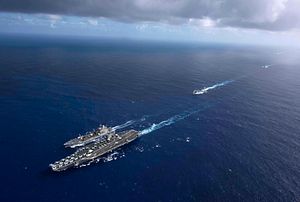With three U.S. Nimitz-class supercarriers in the U.S. 7th Fleet’s area of operations (AOO), the United States Navy is underlining its presence in the Indo-Asia-Pacific unambiguously. The USS Nimitz, USS Ronald Reagan, and USS Theodore Roosevelt carrier strike groups are in the 7th fleet’s AOO, which ranges from the international date line to the western Indian Ocean—a large swathe of the earth’s oceans. This kind of convergence of three supercarriers in rare, but not entirely unprecedented.
When USS Nimitz crossed into the 7th Fleet’s AOO from the 5th Fleet’s AOO earlier this month, observers suggested that the rare convergence of three carrier strike groups in the region would send a strong message to North Korea, which has launched twenty ballistic missiles to date in 2017 and tested one presumably thermonuclear device. The convergence also comes just days before U.S. President Donald J. Trump will depart to East and Southeast Asia on his first trip to the region.
No doubt, the presence of three carriers in the region will be taken seriously by North Korea, which watches the movement of so-called U.S. “strategic assets” near the Korean Peninsula very seriously. To do so, North Korea relies quite a bit on public reportage on U.S. carrier movements, which are normally classified until the U.S. Navy decides to issue public statements clarifying carrier operations. For instance, earlier this year, when the location of USS Carl Vinson became muddled through some misreporting, North Korean state media took for granted that the Vinson strike group was off the Peninsula.
The convergence of three carrier strike groups in the 7th Fleet AOO will, in mid-November, result in a rare exercise, for example. The exercise will take place in the Western Pacific, reportedly—far enough from the Korean Peninsula to avoid sparking any North Korean attempt at a first strike. Publicizing an exercise like this one will not only underline the U.S. Navy’s presence and capability to operate in the Pacific Ocean and, presumably, off the Korean Peninsula, but also serve to reassure allies.
This is precisely the rationale that was given the last time the United States publicized a major exercise in the 7th Fleet’s AOO involving three of its carrier groups. In 2007, USS Kitty Hawk (a conventionally powered carrier decommissioned in 2009) joined USS Nimitz and USS John C. Stennis for the Valiant Shield exercise.
According to a report from the time, a spokesperson for the U.S. Pacific Command’s Joint Task Force 519 said “We want to show that the Pacific region is important, and make sure we maintain peace and stability in the area.” The exercise also reportedly sought to demonstrate the U.S. military’s “ability to rapidly consolidate joint forces in response to a regional contingency,” according to a spokesperson for Valiant Shield.
While the reassurance rationale may be well-placed given the problems posed for the U.S.-South Korea and U.S.-Japan alliances by North Korea’s first-ever flight-tests of an intercontinental-range ballistic missile this year, the exercises will stoke North Korean fears of a bolt-out-of-the-blue U.S. first strike. Part of the reason North Korea keeps track of the movement of “strategic assets” like U.S. aircraft carriers, bombers, and submarines is because some forms of movement may be an indicator of offensive intent.
North Korean anxieties are unlikely to fade anytime soon, especially as the United States has given assurances to South Korea regarding the “enhanced deployment” of its strategic assets on a rotational basis. The United States hasn’t been specific about what this may entail, but the convergence of three supercarriers in the Western Pacific in the coming weeks is likely part of this endeavor.

































